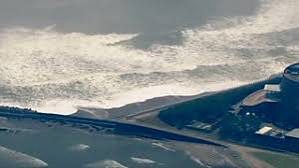On July 30, 2025, a powerful earthquake measuring 8.8 on the Richter scale struck off the eastern coast of Russia, specifically near the Kamchatka Peninsula. This seismic event, one of the strongest recorded in the region, sent shockwaves across the Pacific, triggering widespread tsunami warnings in several countries, including Japan, Hawaii, and parts of the U.S. West Coast. The implications of this earthquake are significant, not only for the immediate region but also for global preparedness in the face of natural disasters.
The Earthquake: A Closer Look
The earthquake occurred in the early hours of Wednesday, July 30, 2025, at approximately 3:45 AM local time. The epicenter was located about 100 kilometers off the coast of the Kamchatka Peninsula, a region known for its seismic activity due to the convergence of tectonic plates. The depth of the quake was recorded at 10 kilometers, which is relatively shallow and often results in more intense surface shaking.
Seismologists have noted that the Kamchatka Peninsula is part of the Pacific Ring of Fire, an area characterized by frequent earthquakes and volcanic eruptions. This latest event is a stark reminder of the geological forces at play in this region and the potential for devastating natural disasters.
Tsunami Warnings and Evacuations
In the wake of the earthquake, tsunami warnings were issued almost immediately. The Japan Meteorological Agency (JMA) was quick to respond, alerting residents along the northeastern coast of Japan to prepare for possible tsunami waves. Approximately two million people were advised to evacuate coastal areas as a precautionary measure. The warnings extended to Hawaii and parts of Alaska, where residents were also urged to stay vigilant.
Reports indicated that tsunami waves were expected to reach heights of up to three meters in some areas, prompting emergency services to mobilize and prepare for potential rescues and evacuations. The U.S. Tsunami Warning Center issued alerts for the West Coast, emphasizing the need for residents to remain informed and ready to act.
Impact on Coastal Communities
The immediate impact of the earthquake and subsequent tsunami warnings was felt across coastal communities. In Japan, local authorities activated emergency response plans, setting up evacuation centers and ensuring that residents had access to necessary resources. Schools and businesses along the coast were closed, and public transportation was suspended to facilitate safe evacuations.
In Hawaii, residents were urged to move to higher ground as a precaution against potential tsunami waves. The state’s emergency management agency coordinated with local officials to ensure that communities were prepared for any eventualities. The situation highlighted the importance of preparedness and the need for effective communication during natural disasters.
Global Response and Preparedness
The earthquake off Russia serves as a critical reminder of the interconnectedness of global seismic activity. Countries across the Pacific Rim are increasingly aware of the need for robust disaster preparedness plans. The international community has emphasized the importance of sharing data and resources to enhance early warning systems and improve response times.
In the aftermath of the earthquake, experts are likely to analyze the event to better understand its implications for future seismic activity. This includes studying the earthquake’s aftershocks and potential long-term effects on the region’s geology. Enhanced monitoring and research efforts are essential to mitigate risks and improve safety measures for coastal communities.
Lessons Learned and Future Considerations
As the world grapples with the implications of this earthquake, several key lessons emerge. First, the importance of timely and accurate information cannot be overstated. Effective communication between government agencies, scientists, and the public is crucial in ensuring that communities are prepared and can respond swiftly to natural disasters.
Second, investment in infrastructure and technology is vital for enhancing resilience against earthquakes and tsunamis. This includes improving building codes, developing early warning systems, and conducting regular drills to ensure that residents know how to respond in emergencies.
Finally, fostering a culture of preparedness within communities is essential. Public education campaigns can empower individuals to take proactive measures, such as creating emergency kits and developing family evacuation plans. By prioritizing preparedness, communities can better withstand the impacts of natural disasters.
Conclusion: A Call to Action
The major earthquake off Russia on July 30, 2025, serves as a stark reminder of the power of nature and the need for vigilance in the face of potential disasters. As tsunami warnings spread across the Pacific, the global community must come together to enhance preparedness and response efforts. By learning from this event and investing in resilience, we can better protect lives and property in the face of future seismic challenges.
In the coming days, as the situation unfolds, it is crucial for individuals and communities to stay informed and heed the advice of local authorities. The lessons learned from this earthquake will undoubtedly shape future disaster preparedness strategies, ensuring that we are better equipped to face the challenges posed by our dynamic planet.
Sourashis Chanda brings readers their unique perspective on Business, Economy, Health and Fitness. With a background in Health and Physical Fitness of 2years, I am dedicated to exploring [what they aim to achieve with their writing, on the sustainable Economy of the country, various pro tips about business, latest goverment news, with some tips in health are and Fitness.






